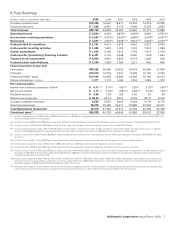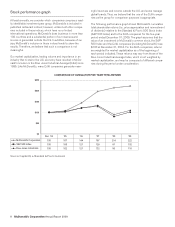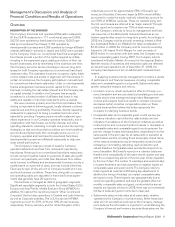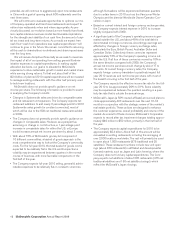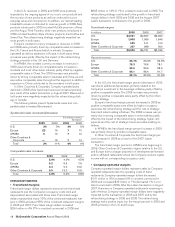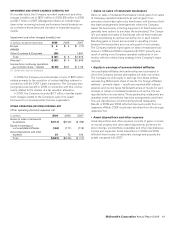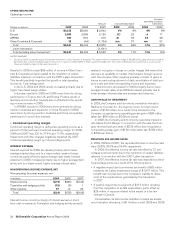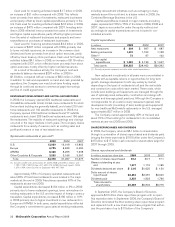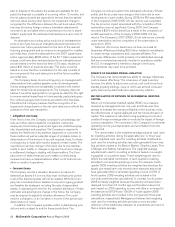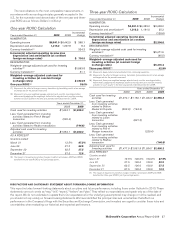McDonalds 2009 Annual Report Download - page 19
Download and view the complete annual report
Please find page 19 of the 2009 McDonalds annual report below. You can navigate through the pages in the report by either clicking on the pages listed below, or by using the keyword search tool below to find specific information within the annual report.
Company-operated margins
In millions 2009 2008 2007
U.S. $ 832 $ 856 $ 876
Europe 1,240 1,340 1,205
APMEA 624 584 471
Other Countries & Corporate 111 128 317
Total $2,807 $2,908 $2,869
Percent of sales
U.S. 19.4% 18.5% 18.7%
Europe 18.4 18.0 17.7
APMEA 16.8 15.9 15.0
Other Countries & Corporate 15.2 15.3 16.1
Total 18.2% 17.6% 17.3%
In the U.S., the Company-operated margin percent increased
in 2009 due to positive comparable sales and the impact of the
refranchising strategy, partly offset by additional depreciation
related to the beverage initiative and higher commodity costs.
The margin percent decreased in 2008 due to cost pressures
including higher commodity and labor costs, partly offset by pos-
itive comparable sales.
Europe’s Company-operated margin percent increased in
2009 and 2008 primarily due to positive comparable sales, partly
offset by higher commodity and labor costs. In 2009, local
inflation and the impact of weaker currencies on the cost of cer-
tain imported products drove higher costs, primarily in Russia, and
negatively impacted the Company-operated margin percent.
In APMEA, the Company-operated margin percent in 2009
and 2008 increased due to positive comparable sales, partly
offset by higher labor costs. The margin percent in 2008 was
also negatively impacted by higher commodity costs.
In Other Countries & Corporate, the Company-operated mar-
gin in 2007 benefited by about 100 basis points related to the
discontinuation of depreciation on the assets in Latam from
mid-April through July 2007.
• Supplemental information regarding Company-
operated restaurants
We continually review our restaurant ownership mix with a goal of
improving local relevance, profits and returns. In most cases,
franchising is the best way to achieve these goals, but as pre-
viously stated, Company-operated restaurants are also important
to our success.
We report results for Company-operated restaurants based
on their sales, less costs directly incurred by that business includ-
ing occupancy costs. We report the results for franchised
restaurants based on franchised revenues, less associated occu-
pancy costs. For this reason and because we manage our
business based on geographic segments and not on the basis of
our ownership structure, we do not specifically allocate selling,
general & administrative expenses and other operating (income)
expenses to Company-operated or franchised restaurants. Other
operating items that relate to the Company-operated restaurants
generally include gains/losses on sales of restaurant businesses
and write-offs of equipment and leasehold improvements.
We believe the following information about Company-
operated restaurants in our most significant markets provides an
additional perspective on this business. Management responsible
for our Company-operated restaurants in these markets analyzes
the Company-operated business on this basis to assess its per-
formance. Management of the Company also considers this
information when evaluating restaurant ownership mix, subject to
other relevant considerations.
The following tables seek to illustrate the two components of
our Company-operated margins. The first of these relates
exclusively to restaurant operations, which we refer to as “Store
operating margin.” The second relates to the value of our Brand
and the real estate interest we retain for which we charge rent
and royalties. We refer to this component as “Brand/real estate
margin.” Both Company-operated and conventional franchised
restaurants are charged rent and royalties, although rent and
royalties for Company-operated restaurants are eliminated in
consolidation. Rent and royalties for both restaurant ownership
types are based on a percentage of sales, and the actual rent
percentage varies depending on the level of McDonald’s invest-
ment in the restaurant. Royalty rates may also vary by market.
As shown in the following tables, in disaggregating the compo-
nents of our Company-operated margins, certain costs
with respect to Company-operated restaurants are reflected in
Brand/real estate margin. Those costs consist of rent payable by
McDonald’s to third parties on leased sites and depreciation for
buildings and leasehold improvements and constitute a portion of
occupancy & other operating expenses recorded in the Con-
solidated statement of income. Store operating margins reflect
rent and royalty expenses, and those amounts are accounted for
as income in calculating Brand/real estate margin.
McDonald’s Corporation Annual Report 2009 17


